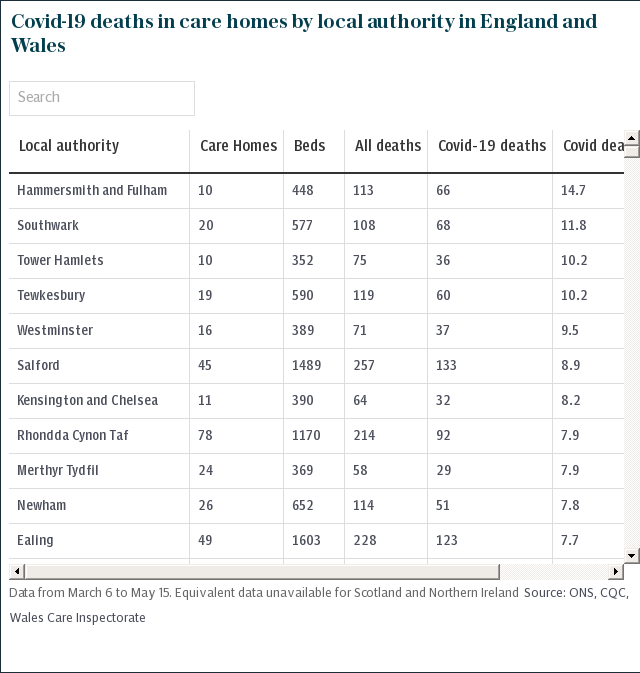Mapped: the Covid-19 care home crisis - how bad has the outbreak been in your area?

Care homes surrounding Cheltenham and in the South Wales Valleys have suffered some of the most severe outbreaks of Covid-19 in the country, according to new analysis.
The equivalent of three per cent of the total capacity of care homes in England and Wales have now lost their lives to Covid-19 - three deaths for every 100 beds - in the period between March 6 and May 15.
In some areas of London the number is as high as 14.7 per cent.
The hotspots of Covid-19 deaths outside London mirror the fallout from large-scale events held before the UK imposed lockdown, including the Cheltenham Festival in mid-March.
While data is not available for the exact care home population within local authorities, analysis of bed capacity across England and Wales helps reveal the scale of the death rate across the country. The number is likely to be an underestimate.
According to research firm Knight Frank, the average occupancy rate in care homes was 90 per cent last year.
And according to the Office for National Statistics the number of excess deaths in care homes has passed 24,000 during the pandemic. More than 12,400 of those have not officially been linked to coronavirus.
The worst outbreaks
Outside London - which has seen six of the ten worst outbreaks - areas of South Wales including Merthyr Tydfil and Rhonnda Cynon Taf have been badly affected.
Each has seen a death rate of 7.8 per cent, with 29 and 92 deaths linked to Covid-19 respectively.
And among Tewkesbury's 19 care homes there have been 60 deaths linked to coronavirus - 10.2 deaths per 100 beds.

The hardest hit areas include Hammersmith and Fulham, with 14.7 deaths per 100 beds, and Southwark with 11.2 deaths per 100 beds.
Care home operators have linked the scale of the outbreaks to two policy documents which together ordered NHS hospitals to transfer hundreds of elderly patients to care homes without necessarily being tested.
In guidance since branded “reckless”, Whitehall officials also reassured care homes that they could take in coronavirus patients as long as certain measures were put in place.
The Department for Health and Social Care said early advice "reflected the situation at the time" when there was "no community transmission".

According to data from the Office for National Statistics, deaths in care homes across England and Wales peaked around April 17, more than a week later than deaths in hospitals, and a month after fresh guidance was issued to providers.
Public Health England’s guidance for social or community care and residential settings on Covid-19 was published at the end of February and remained the only Government advice for care homes on how to protect elderly residents from coronavirus until mid-March.
At the time it stated: “It remains very unlikely that people receiving care in a care home or the community will become infected.”
At the point it was issued, there were still just a handful of coronavirus cases in Britain, thought to have been contracted abroad.
Care homes 'disproportionately affected'
The number of excess deaths in care homes has now reached almost 25,000 during the pandemic, and the proportion of Covid-19 deaths which took place in care homes reached 44 per cent in the week ending May 15.
But more than 12,400 excess deaths in care homes have not been officially linked to Covid-19 on their death certificates.
Statistician Prof Sir David Spiegelhalter, of the University of Cambridge, has said they are unlikely to have been exported from hospitals, suggesting they are more likely to be undiagnosed Covid-19 deaths.

Scientists have also warned lessons must be learned from the plight of care homes during the pandemic, who were under-resourced and "disproportionately affected".
Prof Carl Heneghan, Director of the Centre for Evidence-Based Medicine at the University of Oxford, said: "There is no doubt care homes need more resources in the future to make sure they are not disproportionately affected as they have been in this outbreak.
"The nature of this disease is that if a single infected person walks into a home you get sporadic outbreaks, and if you infect one person in a care home you can infect multiple people very rapidly."
William Liang of research firm LiangBuisson has estimated around a tenth of the UK's 10,000 care homes could go bust as a result of the pandemic.
He said the significant number of deaths in care homes and drop in the number of new residents was likely to drag occupancy rates down to 75pc. “That puts care homes on the borderline where business is no longer viable,” he said.
Two homes so far have temporarily closed, Friary Lodge in north London and Temple Court in Northamptonshire, and are moving residents into alternative accommodation.
A Department of Health and Social Care spokesperson said they have announced a £600m Infection Control Fund for care homes and more funding to local authorities to deliver social care.
“Every death from this virus is a tragedy and our deepest sympathies go out to the families who have sadly lost loved ones," they said.
“Supporting the social care sector throughout this pandemic, both at a national and local level, has always been a priority.
“We are also working closely with Local Resilience Forums to supply PPE to the areas who need it most and all care home residents and care staff can now receive testing.’’

